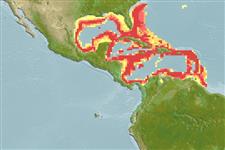Common names from other countries
Classification / Names / Names
Namen | Synonyme | Catalog of Fishes (gen., sp.) | ITIS | CoL | WoRMS
Environment: milieu / climate zone / depth range / distribution range
Ökologie
Riff-verbunden; tiefenbereich 0 - 2000 m (Ref. 87091). Tropical; 33°N - 8°N, 98°W - 58°W (Ref. 847)
Western Atlantic.
Length at first maturity / Size / Gewicht / Alter
Maturity: Lm ? range ? - ? cm
Kurzbeschreibung
Morphologie
Colonies are encrusting to massive. Corallites with numerous septa tightly compacted giving a smooth surface. Septa are uniformly separated and reduce numbers from the wall to the columella without forming many fan-like fusions. Usually light reddish brown in color.
Zooxanthellate (Ref. 116012). Common throughout the Caribbean on protected shallow reefs or deeper reefs (Ref. 415).
Life cycle and mating behavior
Geschlechtsreife | Fortpflanzung | Ablaichen | Eier | Fecundity | Larven
Mature gametes are shed into the coelenteron and spawned through the mouth. Life cycle: The zygote develops into a planktonic planula larva. Metamorphosis begins with early morphogenesis of tentacles, septa and pharynx before larval settlement on the aboral end (Ref. 833).
Collin, R., M.C. Díaz, J. Norenburg, R.M. Rocha, J.A. Sánchez, M. Schulze, A. Schwartz and A. Valdés. 2005. (Ref. 415)
IUCN Rote Liste Status (Ref. 130435)
CITES Status (Ref. 108899)
Not Evaluated
Nutzung durch Menschen
| FishSource |
Tools
Mehr Information
Alter/Größe
Wachstum
Länge-Gewicht
Länge-Länge
Morphologie
Larven
Dichte
Internet Quellen
Estimates based on models
Preferred temperature
(Ref.
115969): 6.2 - 16.9, mean 10.3 (based on 212 cells).
Preiskategorie
Unknown.
